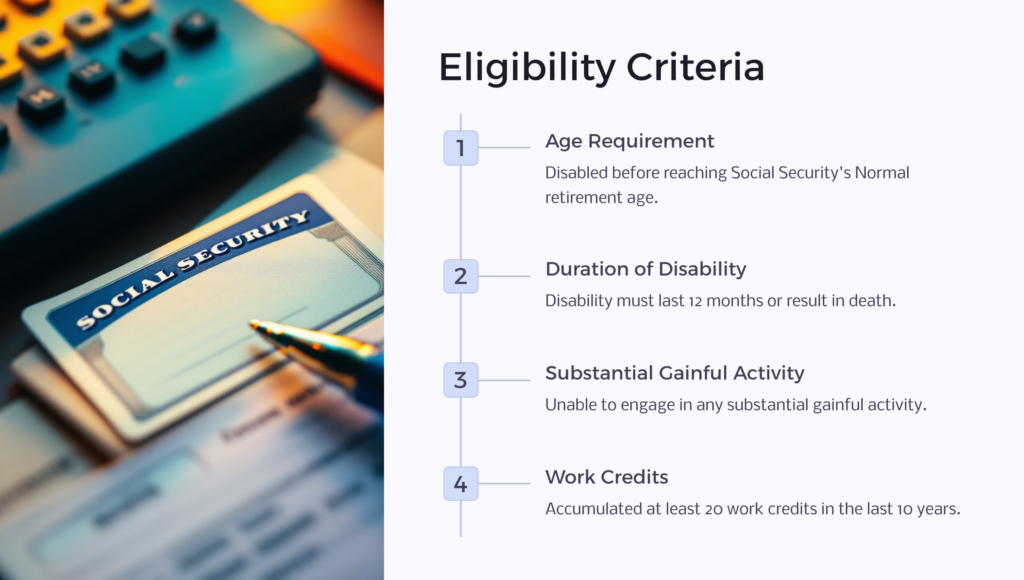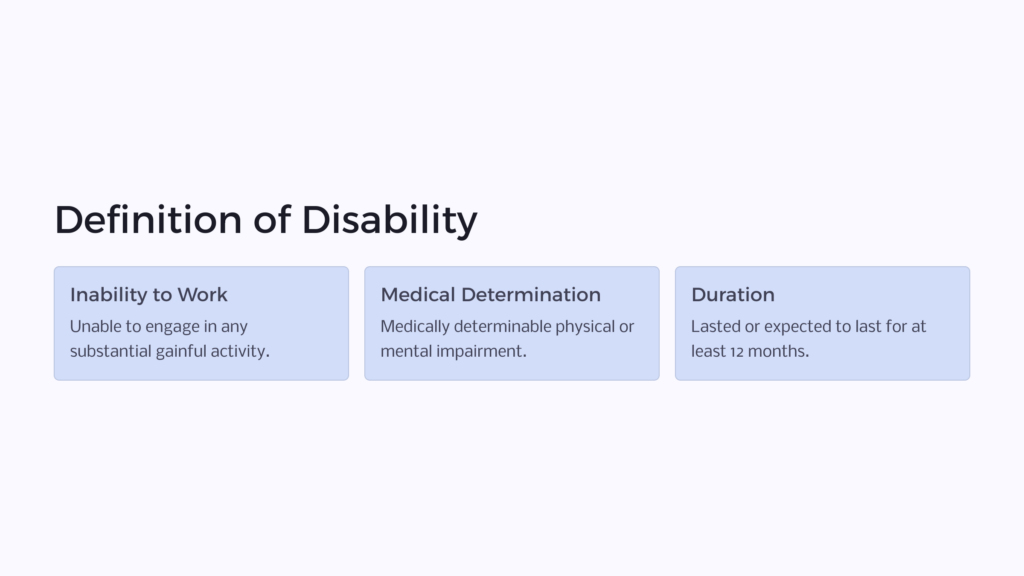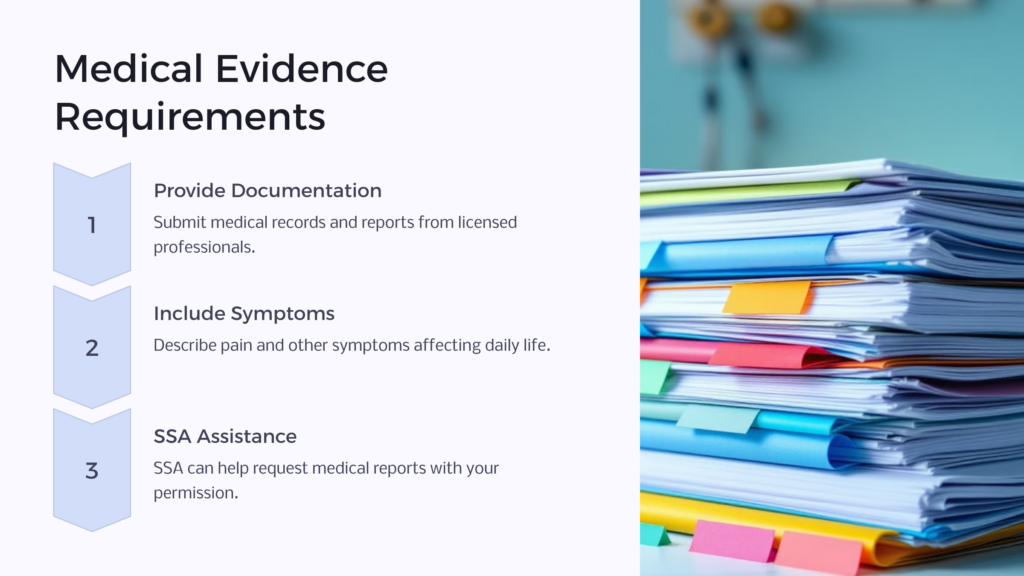Whether you’re applying for SSD benefits for yourself or others, it’s extremely important to fill out the application form completely, correctly, without omissions, and with the required paperwork enclosed along with it. Having your initial application denied can make you so discouraged that you’ll give up on SSD and miss out on the benefits you deserve. This section and the next may help you to avoid an immediate denial or needless delays.
The application process is complex and can take much time and effort. But several million Americans go through it each year and, if successful, are very glad they did. After all, the average estimated disability benefit in 2020 for a disabled worker is $1,258.00 per month — $15,096 per year — so it’s well worth applying if a disability keeps you from earning a decent income.
4 Questions to Determine if You Meet the Social Security Disability Requirements

- Did you become disabled six months or more before you reached Social Security’s Normal (Full) retirement age, which is between age 66 and 67, depending on the year you were born?
- If you answered “No,” you are not eligible for SSD benefits.
(But you may be eligible for SSA retirement benefits or SSI benefits.) - If you answered “Yes,” then proceed to the next question.
- If you answered “No,” you are not eligible for SSD benefits.
- Do you have a disability that has lasted or is expected to last 12 months or more, or result in death? (Don’t count short unsuccessful work attempts as interruptions in counting the twelve months.)
- If you answered “No,” you are not eligible for SSD benefits.
- If you answered “Yes,” then proceed to the next question.
- Does your physical or mental condition prevent you from engaging in any “Substantial Gainful Activity” (SGA) to earn an income?
To answer, you need to know what the SSA currently calls “substantial.” In 2020, if you are blind (as per the SSA’s definition), you can earn more up to $2,110 a month; if not blind, the limit is $1,260 per month. Note that countable earnings can be reduced by impairment-related work expenses.- If you answered “No,” you are not eligible for SSD benefits. .
- If you answered “Yes,” then proceed to the next question.
- Have you accumulated at least 20 Social Security (work) credits in the last 10 years prior to the onset of your disability, and at least one additional credit for every year by which your age exceeds 42? Or, if you are under age 31, have you earned half of the possible work credits for every year that has elapsed since you turned 21. (A minimum of six is required.)
Normally, workers who pay into the Social Security system (via FICA payroll contributions or self-employment tax) receive four credits per full or partial year. Like insurance premiums, you must pay in (pay taxes) to receive benefits.- If you answered “No,” you are not eligible for SSD benefits. This is often hard to figure out, if you are not sure, file an application.
- If you answered “Yes,” then proceed to the Listing of Impairments.
- If you have any doubt about your possible eligibility, file an application to get a formal decision. Stated another way be careful not to incorrectly rule out your potential eligibility.
Please Note: If you became disabled before age 22 and you have a parent who is either receiving Social Security Disability or Retirement or is deceased, you may be allowed to collect dependent or survivor disability benefits based on the work credits of your parent(s). Their own benefits would not be affected.
IN ADDITION: To be eligible for SSD benefits, you must provide proof that you cannot perform SGA in any occupation. ONE way to qualify is to have an illness that meets or equals the severity of those in the SSA’s Listing of Impairments.
The Listings describe for each major body system impairments considered severe enough to prevent an applicant from doing any gainful activity without consideration of work they have done in the past, their work skills, education, or age. Most of the listed impairments are permanent or expected to result in death, but for some, the listing includes a specific statement of duration.
Part A of The Listings lists impairments in the following categories as they pertain to adults age 18 or over. The categories are:
- Musculoskeletal System
- Special Senses and Speech
- Respiratory System
- Cardiovascular System
- Digestive System
- Genitourinary Impairments
- Hematological Disorders
- Skin Disorders
- Endocrine Disorders
- Impairments That Affect Multiple Body Systems
- Neurological
- Mental Disorders
- Malignant Neoplastic Diseases
- Immune System Disorders
Part B of the Listings lists impairments pertaining to children. Medical evidence — signs, symptoms and/or laboratory findings — is required by the SSA to document any disability claim. Pain or other symptoms are also considered, but are not usually enough to substantiate a claim. These impairments and conditions are all those listed in Part A (above) plus Growth Impairments.
Medical evidence: Applicants are responsible for providing medical evidence proving they have a listed impairment and what its severity is or if their condition is not in The Listings that the condition prevents performing substantial gainful activity in any occupation. However, if you need assistance in obtaining this data, the SSA — with your permission (provide your doctors’ names and contact information, the dates you were examined or treated, etc.) — can help request the medical reports required. Acceptable medical sources include licensed physicians, psychologists, optometrists, podiatrists…whatever type of medical professional is relevant.
What is Disability According to Social Security Law?

Gain an understanding of the definition of disability as defined by the Social Security law and see how working while disabled may be allowed when applying for Social Security or Supplemental Security Income disability benefits.
How Social Security Law Defines Disability
For adult claimants including disabled adult children, the Social Security Administration (SSA) answers the question “What is disability?” with the following definition: “[Disability is] the inability to engage in any substantial gainful activity by reason of any medically determinable physical or mental impairment which can be expected to result in death or which has lasted or can be expected to last for a continuous period of not less than twelve months.”
Any Occupation
The word “any” in Social Security’s definition of disability means that in addition to being unable to perform jobs you have done in the past, to be considered disabled you must also be unable to work in occupations that are new to you. Stated differently, to be found disabled, you must be unable to perform any occupation that you could perform if you did not have your current physical and/or mental limitations.
When Is Continuous Not Continuous?
Let’s move the end of the definition of disability, which tells us that you must have been or be expected to be disabled for a continuous period of not less than twelve months. This seems pretty clear and yet a notable exception allows twelve months to be counted as continuous even if you work performing substantial gainful activity (SGA) before you have been off work for twelve months.
Here’s how this works: If you stop work due to illness or injury and then try to go back to work full time or part time before you have been off for twelve months and you have to stop work again in less than six months due to the same medical or a related medical condition, the short period of work will be considered an unsuccessful work attempt. The unsuccessful work attempt does not start the clock over in counting the twelve “consecutive” months. In fact, the work is deemed not substantial gainful activity because you could not sustain it.
Before some people finally stop working and apply for benefits, they make multiple attempts to return to work, each failing in less than six months due to health. These multiple work attempts can all be treated as unsuccessful work attempts. This is true whether the worker goes back to the same job or tries different jobs.
To receive maximum benefits, it is important to claim the earliest date of cease work possible as the date your disability began, which would be the last cease work before the first short, unsuccessful work attempt(s). If you are uncertain of your choice, a Social Security disability attorney or a Social Security claims representative can help you pick the most advantageous date.
When is $1,260 not $1,260?
Inability to perform substantial gainful activity (SGA) is usually evaluated in dollar terms. In 2020, the SGA threshold is $1,260 gross wages or net profit from self-employment. (Work hours and work duties are also considered in new and recent claims filed by the self-employed.) This means that even if you have reduced your hours due to your health, you will not be eligible for benefits if you are earning at the SGA level. However, if you have Impairment-Related Work Expenses (IRWE’s), you can reduce your countable earnings by the cost of those expenses. For example, if you are earning $1,280 and you have $150 monthly in allowable IRWE’s, which can include medication taken for your disabling condition, your countable earnings would be $1,130 ($1,280 – $150) and below SGA. As such, your work activity would not cause you to be denied. (Note that the SGA threshold for blind individuals is $2,100 and countable work earnings can also be reduced by IRWE’s.)
The Word “Earn” is Key
One other thing to consider in the SGA evaluation of a new claim is whether all your pay or all the pay of the disabled person you are assisting is actually earned. Sometimes a benevolent employer will keep a loyal employee on the job when the person’s productivity is substantially below the normal quality or quantity. Alternatively, the employer may allow a lot of absences without docking pay even though all sick or annual leave has been used up. In those two examples, the worker is being subsidized and is not earning the full wages being paid. If this is the case, consider filing a claim while you are still working and obtain a statement from your employer about the special accommodations you are receiving on Form SSA-3033, which you can download and print from this website to submit with your claim.
Proof Needed

Let’s focus for a moment on the phrase “medically determinable physical or mental impairment” from Social Security’s definition of disability. The phrase makes it clear that it is not enough for you or even your doctors to assert that you have a certain diagnosis and certain physical or medical limitations. To support your claim and prove disability, all assertions including those by your attending physicians need to be backed up by records of clinical findings and/or test results
How can I tell if I will meet Social Security Disability requirements?
Sometimes we can’t be sure if we meet Social Security disability requirements. Even your doctor’s assessment of whether or not you qualify may not be accurate. This is because Social Security has its own specific definition of disability, which is fairly complex and even allows for you to do some work.
Unsuccessful Work Attempts
It can also be difficult to determine whether you have been or will be disabled long enough to receive benefits. For example, if you returned to work for six months or less and stopped work again for nine months due to the same disability, your return to work might be treated as an unsuccessful work attempt, so that months off work on either side of the return to work might be combined to meet the required twelve-month duration. Additionally, your work hours and earnings might be low enough that you could qualify for benefits while you continue to work part-time.
How a Social Security Disability Law Firm Might Know
Talking with an attorney who is experienced with Social Security Disability claims can be helpful, because he or she will be very familiar with Social Security Disability law. If you accurately describe all your medical conditions and past injuries, your current work activity, and your work history, the attorney will be able to give you an idea of whether you may qualify. And, of course, the way to find out for sure is to file an application with the Social Security Administration and get a formal determination of whether you meet the Social Security Disability eligibility requirements.

 Benefits.com Advisors
Benefits.com Advisors
With expertise spanning local, state, and federal benefit programs, our team is dedicated to guiding individuals towards the perfect program tailored to their unique circumstances.
Rise to the top with Peak Benefits!
Join our Peak Benefits Newsletter for the latest news, resources, and offers on all things government benefits.




















